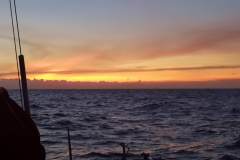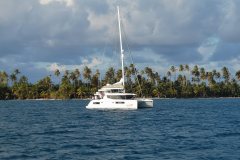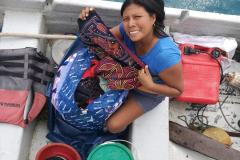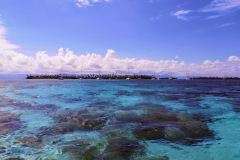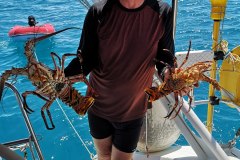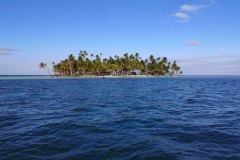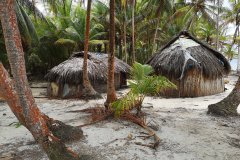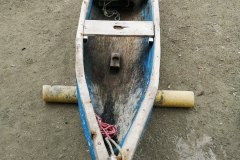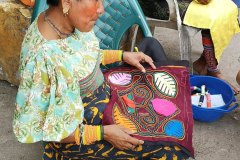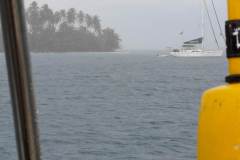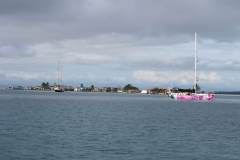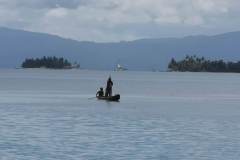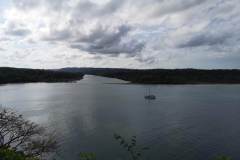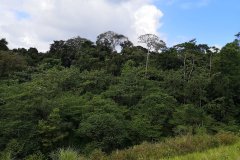Santa Marta to Shelter Bay 22nd to 29th January
Another briefing (and prize-giving) organised by the World ARC team and we were nearly ready for departure on the next leg of our trip. This was to take us to the northern entrance of the Panama Canal, via the San Blas Islands off the NE coast of Panama. Graham completed the paperwork (the most of any country he had been in), retrieved our passports, and after some final shopping we were ready to go.
After days of non-stop 30 knots wind from the east, the wind had dropped during our stay, and the morning of the 22nd saw us with a light wind from the west! The choice of tack was therefore starboard towards the Colombian coast, or port out to sea and hopefully better winds. The view back to land (and the plotter) showed that we were actually heading north at best, with about 3 knots of current against us from the west. We, and everyone else, finally put the motor on and dropped sail. At best, we made 4 knots over the ground throughout the night, watching various shore lights slowly disappearing into the distance. The morning brought wind from astern, so it was up with Parasailor. We also finally managed to catch a decent sized tuna, which gave us several meals. Unfortunately, the lack of wind meant that we would have a day less in the San Blas Islands, if and when we arrived. The wind finally went more on the beam, and speed picked up. With the wind dropping on the third day, it was time to turn the motor back on to try and reach anchorage before nightfall. It was not to be, and we passed through the wide gap between some islands in the dark.
The entrance to the anchorage was a narrow passage between some reefs and we agreed with two other yachts that we would raise our keel and lead them in, reporting on depths. It was at this moment that our echo sounder decided to stop working. Motoring in through the reefs, in darkness, with no echo sounder was a definite no, and we debated whether we should head back out to sea and wait for daylight. Instead, all agreed that we would now be the third boat in the convoy, following very close behind the second yacht. One of the earlier arrivals had provided some waypoints and we kept exactly on the plotted track. It was a nervous fifteen minutes before the lead yacht announced that their depth soundings were increasing, and that we were now safely in the anchorage.
Morning showed us that we were in a picture-perfect anchorage, surrounded by small islands covered in palm trees, with the surf breaking on the reef to the north, and a distant view of mountains to the south. We had some early visitors as a dugout canoe arrived, wanting to sell us some of the locally embroidered “molas”. A second canoe arrived with lobsters, so dinner was soon sorted. The San Blas Islands, properly called Guna Yala, are home to the Kuna people, and are semi-autonomous. Most of the islands are uninhabited or have a few dwellings, while some are completely covered by shacks and houses. The elevation of the islands is only a couple of metres above sea level, and they are certain to be engulfed by sea level rises. Ecotourism is now bringing money to the islands, and one of the islands beside us had a number of huts for the genuine “desert island” experience. We visited one island to see molas being made (see photos) and enjoyed a number of swims and snorkels in the beautiful water. We also did some boat maintenance; the biggest job being checking all the wiring connections before deciding that it was a problem with the depth sensor. Luckily, one of the other boats had a spare, and we had sufficient cabling to install the new sensor and get it working.
We then headed over to the island of Porvenir, where we would officially be checked into Panama. As we lifted the anchor that morning we had noticed a number of rain storms, and when we saw one coming our way, we suggested to the boat departing with us that we delay while the rain passed. They refused, so we raised anchor and motored out. As Graham and I, in t-shirts and shorts, got soaked to the skin by the rain, we looked over at the other boat to see them in full oilskins!
Porvenir has an airstrip, a hotel, and a passport office. The neighbouring island seemed to have buildings covering every possible centimetre. At anchor that evening, we heard splashing and went on deck to investigate. There were about a dozen dolphins chasing a large shoal of fish. We got out the torch, and could actually follow individual dolphins as they raced through the water, doing u-turns as the fish tried to escape. An amazing sight. There was time to visit one more anchorage in these amazing islands before we set sail for Shelter Bay marina to learn about our canal crossing.
We left these beautiful islands at midday on the 28th for our overnight sail as we wanted to be certain of getting through the shipping at the entrance to the canal in daylight. Three other yachts left at the same time, partly for protection, as this stretch of the coast has seen some piracy recently, so we all kept well offshore and were relieved as we turned south west for the canal. As we approached the breakwater we counted over 50 ships at anchor, while others passed down the main channel, either to the canal or to the port of Colon. Ahead, we could see the new bridge over the entrance to the Panama Canal and the two breakwaters at the entrance to the bay. At the breakwater, it was a sharp right turn to follow it to the Shelter Bay marina, where we were to be based for a few days. Barracuda had finally left the Atlantic Ocean.
Graham’s brother, Angus, joined us bright and early the next morning, having flown in to Panama City and then taxied across the isthmus. He would be staying with Barracuda for a few weeks and getting off in the Galapagos. Our time in Shelter Bay was fairly busy; washing to do, a full rig inspection by a qualified rigger, and the main was put in for some repairs. The sailmaker was busy and agreed that we would pick up the main in Panama City, a couple of days after our arrival there. An ARC briefing told us what to expect during the canal trip, and which “nest” of three boats we would be in. We were officially measured and given Barracuda’s certificate and transit number. If you are over 60 feet, you get to transit by yourself, with a pilot. Otherwise, you travel in a nest (raft) of three yachts, each with an advisor on board. Although the nest only needs four mooring lines, each yacht must have four in case the nest comes apart. You must also have four crew plus helm. The mooring lines were provided by ARC, along with some equally big fenders. There were about 40 ARC yachts going through the canal over a period of about four days; some crew made the trip to Panama City, then came back to help short-handed crews.
I had time to visit Fort San Lorenzo, located at the mouth of the Chagres River, and the original export route for South American gold, along with Portobelo to the east. I hitched a ride through the jungle and arrived at a spectacular location, above the river, with great views out to sea. The original fort had been destroyed Captain Morgan, rebuilt, then destroyed by Francis Drake.
Panama was coming to the end of the dry season and so dates for transiting the canal were changing almost daily. Finally, we were told that we would be leaving the following evening. The next morning, at about 9am, we got the radio message, “you are leaving at midday”, so there was a final rush of preparation before motoring out into the bay and waiting for our advisors to arrive.

